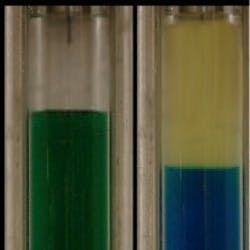- Rapid Expansion of Supercritical Solution (RESS),
- in which a drug is dissolved in an SCF such as CO
- and then sprayed into a collection chamber. The solvent is then rapidly removed, resulting in well-defined, uniform drug particles. RESS is a simple and effective technique, but is restricted by the limited solubility of drugs in SCFs.
- Gas Anti-Solvent (GAS)
- is another popular technique, shown in
- (
- ). In this case, a gas such as CO
- is added to an organic solution of a desired drug, resulting in the expansion of the organic solvent and the precipitation of uniform drug particles. The precipitation is easily tuned by adjusting temperature and CO
- pressure, allowing close control of particle size and morphology. GAS takes advantage of the organic solvent’s strength coupled with the tunable solvent expandability. However, it requires semi-batch operation.
- Supercritical Anti-Solvent (SAS) and Solution Enhanced Dispersion by Supercritical fluids (SEDS)
- allow for continuous operation and control. In both of these processes, the drug solution is sprayed into the SCF or mixed with the SCF and sprayed into a collection vessel. Nozzle design and inlet stream flow rates can be adjusted to control the process while utilizing the solvent’s tunability.
- Gas eXpanded Liquids (GXLs),
- organic solvents mixed with carbon dioxide gas, which expands their volume by a factor of 10 or more. Nutraceuticals production has moved in the direction of GXLs, by using ethanol cosolvent as a polar modifier with scCO
- . This results in a solvent medium that can combine synthesis and product recovery in a simplified and efficient “one pot” system.
- Near-critical Water (NCW),
- which offers organic solubilities and the potential for reversible acid/base catalysis.
- Organic/Aqueous Tunable Solvents (OATS),
- or water-soluble catalysts (including both aqueous organometallic complexes and enzymatic biocatalysts) that can perform difficult transformations on highly hydrophobic substrates.
- Miscible water/organic systems,
- where a catalyst is modified for aqueous solubility;
- Miscible poly(ethylene glycol)/organic systems,
- where a catalyst is modified for PEG solubility;
- Immiscible fluorous/organic liquid/liquid or solid/liquid systems,
- where the catalyst is modified for fluorous solubility;
- Immiscible water/organic systems
- involving phase transfer catalysts.
http://www.che.gatech.edu/ssc/eckert/.Dr. Christopher L. Kitchens is a Post Doctoral Researcher in the Eckert-Liotta Joint Research Group at Georgia Institute of Technology. He received a B.S. in Chemistry from Appalachian State University and a Ph.D. in Chemical Engineering from Auburn University, where he worked on nanoparticle synthesis and processing in tunable fluids.
Dr. Jason P. Hallett is a Research Engineer in the Eckert-Liotta Joint Research Group at Georgia Institute of Technology. He received a B.S. in Chemical Engineering from the University of Maine and a Ph.D. in Chemical Engineering from Georgia Institute of Technology, where he worked on novel methods for homogeneous catalyst recycle.References
Dr. Jason P. Hallett is a Research Engineer in the Eckert-Liotta Joint Research Group at Georgia Institute of Technology. He received a B.S. in Chemical Engineering from the University of Maine and a Ph.D. in Chemical Engineering from Georgia Institute of Technology, where he worked on novel methods for homogeneous catalyst recycle.References
- McHugh, M; Krukonis, V., Supercritical Fluid Extraction: Principals and Practice, Butterworth Publishers, Stoneham, Mass., 1986.
- York, P.; Kompella, U.; Shekunov, B., Supercritical Fluid Technology for Drug Product Development. Drugs and the pharmaceutical sciences ; v. 138 M. Dekker, New York, 2004.
- Staks, C.; Liotta, C.; Halpern, M., Phase-Transfer Catalysis: Fundamentals, Applications, and Industrial Perspectives. Chapman & Hall, New York, 1994.
- Xie, X.; Brown, J.; Joseph, P.; Liotta, C.; Eckert, C.,“Phase-Transfer Catalyst Separation by CO2 Enhanced Aqueous Extraction”, Chemical Communications, 2002, 1156.
- Eckert, Charles A.; Liotta, Charles L.; Bush, David; Brown, James S.; Hallett, Jason P. “Sustainable Reactions in Tunable Solvents.” J. Phys. Chem. B 2004, 108, 18108.
- Brown, J.; Gläser, R.; Liotta, C.; Eckert, C.,“Acylation of Activated Aromatics without Added Acid Catalyst”, Chem. Commun., 2000, 1295-1296.
- Chandler, K.; Deng, F.; Dillow, A.; Liotta, C.; Eckert, C., “Alkylation Reactions in Near-Subcritical Water in the Absence of Acid Catalysts,” Ind. Eng. Chem. Res., 1997, 36, 5175.
- Nolen, S.; Liotta, C.; Eckert, C.,“The Catalytic Opportunities of Near-Critical Water: A Benign Medium for Conventionally Acid and Base Catalyzed Organic Synthesis,” Green Chem., 2003, 663.
- West, K.; Wheeler, C.; McCarney, J.; Griffith, K.; Bush, D.; Liotta, C.; Eckert, C.; “In Situ Formation of Alkylcarbonic Acid with CO2” J. Phys. Chem. A, 2001. 105, 3947.
- Xie, X.; Liotta, C.; Eckert, C., CO2-Catalyzed Acetal Formation in CO2-Expanded Methanol and Ethylene Glycol. Ind. Eng. Chem. Res. 2004, 43, 2605.
- Chamblee, T.S., R.R. Weikel, S.A. Nolen, C.L. Liotta, and C.A. Eckert, “Reversible in situ acid formation from beta-pinene hydrolysis using CO2 expanded liquid and hot water” Green Chem., 2004, 6.
- Nolen, S.; Lu, J.; Brown, J.; Pollet, P.; Eason, B.; Griffith, K.; Glaser, R.; Bush, D.; Lamb, D.; Eckert, C.; Liotta, C.; Thiele, G.; Bartels, K.,“Olefin Epoxidations Using Supercritical Carbon Dioxide and Hydrogen Peroxide Without Added Metallic Catalysts or Peroxy Acids,” Ind. Eng. Chem. Res., 2002. 41, 316.
- West, K.; Hallett, J.; Jones, R.; Bush, D.; Liotta, C.; Eckert, C. "CO2-Induced Miscibility of Fluorous and Organic Solvents at Ambient Temperatures." Ind. Eng. Chem. Res., 2004. 43, 4827.
- Lu, J.; Lazzaroni, M.; Hallett, J.; Bommarius, A.; Liotta, C.; Eckert, C. “Tunable Solutions for Homogeneous Catalyst Recycle.” Ind. Eng. Chem. Res. 2004, 43, 1586.






